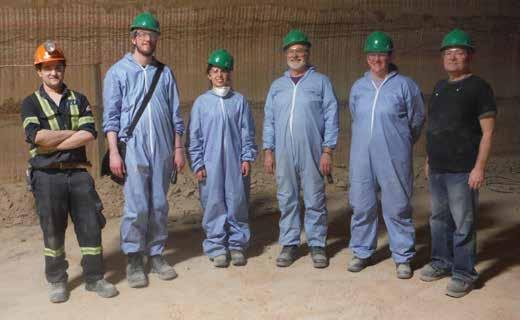
2 minute read
Critical research and development set to enhance mine safety and productivity
Sask Polytech Digital Integration Centre of Excellence delivers underground beacon positioning system working prototype
DICE team visiting an underground mine for a 3D positioning experiment. Photo was taken pre-COVID-19.
The International Minerals Innovation Institute (IMII), Nutrien, BHP, and Saskatchewan Polytechnic’s Digital Integration Centre of Excellence (DICE) Technical Access Centre recognize that mine safety is top of mind for many Saskatchewan companies. While GPS-derived coordinates for surface assets is now commonly used by mining companies to improve safety and advance automation, tracking the positions of equipment in underground mines has remained elusive. A new underground wireless positioning system being developed by DICE to enhance mine safety is hoping to solve that problem.
Thanks to support from IMII and mineral member companies BHP and Nutrien, Dr. Terry Peckham, the DICE director and research chair at Sask Polytech, is nearing completion on a prototype that uses a system similar to GPS technology to identify the positions of people and equipment in an underground mine, within 30 centimetres of their actual location. This technology will enable companies to operate more efficient-
ly by improving mine safety, process optimization, and automation.
“Applied research projects continue to put Saskatchewan and Sask Polytech at the forefront of innovation in mine safety and optimization,” says Dr. Larry Rosia, Sask Polytech president and CEO. “Excellent progress has been made since this DICE project was launched two years ago. This technology will be a game-changer for safety in the mining industry.”
According to Al Shpyth, IMII’s executive director, harnessing technology is central to making mining safer and more efficient, and this project is a building block to safely deploying digitally enabled equipment.
“This project is an example of how we can align our digital innovation strategy with the needs of our members’ operations, engage and train tomorrow’s digital workforce, and strengthen the partnership we have with DICE – a win-win-win,” says Shpyth. program and the NSERC Applied Research and Development program. Through this program, NSERC aims to increase innovation by enabling Canadian polytechnics and colleges to increase their capacity to work with private sector companies. It supports applied research and collaborations that facilitate commercialization, as well as technology transfer, adaptation and adoption of new technologies.
IMII, BHP and Nutrien have invested $314,000 in cash and in-kind resources to develop the technology. The Natural Sciences and Engineering Research Council (NSERC) has contributed $324,000 to the project through its Applied Research and Development program. The value of the final project is almost $638,000.
“Despite the logistical challenges that COVID-19 has created for this project, the mining partners and Sask Polytech researchers have been able to continue their efforts to deliver a working prototype that meets our mining partners’ initial requirements,” says Dr. Peckham. “Our next steps are to work with our industry partners to continue to refine the technology and adapt it to various use cases.”
With its focus on data-driven applied research, DICE works collaboratively with various industry partners, including mining companies, to help solve their data challenges, particularly those related to data integrity, data transmission, and data analysis and storage. By partnering with DICE, organizations have access to exceptional computational facilities, faculty expertise, and talented student researchers, along with research and development funding and a vast network of connections. The DICE team of specialists and technologists are all experienced in providing digital solutions focused on data across a spectrum of industries.









